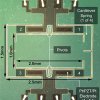.jpg)
Hearing aids have been getting smaller and more capable lately, but there’s a lot more that can be done to improve their performance as researchers at University of Texas at Austin are showing. They have managed to mimic the hearing abilities of the Ormia ochracea fly in a microphone only two millimeters in width. The fly is known for its ability to quickly locate chirping crickets, a feat because sound waves are about the size or larger than the insect itself, so detecting the source of waves using two ears that differentiate the timing of sounds coming in is nearly impossible at this scale.
The fly instead has a special structure about 1.5 mm long that can detect the phase shift of incoming sound waves as they travel between the left and right ear. This allows the fly to quickly find and land on a cricket. The researchers at UT Austin went ahead and built their own microscopic seesaw that uses piezoelectric materials to convert mechanical motion into an electrical signal. Both the flexing and rotation of the seesaw beam can be measured precisely, which allows the device to identify the direction sounds are coming in much like the Ormia ochracea fly can. The researchers believe the new microphone has great potential in hearing aid applications because of its sensitivity while using very little energy. They also envision the technology allowing people who wear hearing aids to focus in on specific sources of sound, while minimizing most of the peripheral noise, a major reason many refuse to wear the aids now.
Source:fly Ormia ochracea
Fly-inspired Microphone To Make Hearing Aids Smaller, Even Smarter

